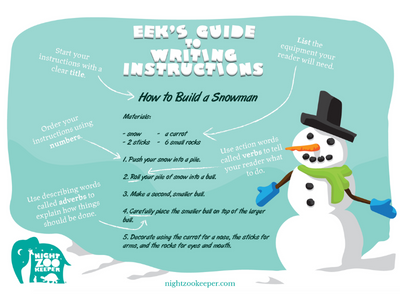Instruction Writing
Free instruction writing guide & worksheets

Home > Worksheets > Writing Styles > Instruction Writing
Writing clear instructions is a skill your child will develop early and will have use for throughout their life. Instructions have specific characteristics that ensure readers are able to follow and understand what they are being told to do.
Types of instruction writing include:
- Step-by-step guides
- Instruction manuals
- Cooking recipes
- Travel guides
Learning about instruction writing will also improve your child’s explanation writing skills, as it requires attention to detail, critical thinking and logic. Writing instructions can also help children understand the importance of clarity in writing and teach them how to use adverbs or adjectives to add relevant context and helpful advice.
We’re here to help your child writer master the art of instruction writing! This page includes guidance from education experts on how you can teach writing instructions to your child, including free worksheets for them to practice.

What is instruction writing?
When writing a set of instructions, your child will need to have attention to detail and knowledge of what they’re explaining, to ensure that the reader can successfully follow their directions.
Instructions are written for all kinds of activities, from cooking, to DIY, to gaming! Explicit instructions are needed to ensure that the reader is able to successfully follow each step until they finalize the product, dish, or project being worked on.
At elementary/primary school level, children should focus on making instructions factual and impartial, to ensure they are writing clear, explicit instructions.
How to write a good set of instructions
Here's a list of "instructions" for your child to write their own instructions:
- Start all instruction writing pieces with a clear title and brief introduction.
- List the equipment/materials the reader will need underneath the title.
- Order each instruction, sequentially, using numbers.
- Ensure that each step follows a logical sequence.
- Use technical terminology when needed.
- Use action words (verbs) to tell the reader what to do. Focus on a single task per step.
- Use describing words (adverbs) to explain how things should be done in detail.
- Ensure your child is revising their work as they write each instruction, and that they’re using a neutral point of view.
Imperative Verbs
A distinctive component of any good set of instructions is the use of imperative verbs (sometimes called "command verbs"). Imperative verbs are verbs that form a command or request. Sentences with imperative verbs provide directions, give commands, or offer advice to the reader. Without imperative verbs, instructions may feel incomplete and not be as clear as they could be.
Here is a list of imperative verbs that are useful for instruction writing:
- Set
- Pick
- Measure
- Hold
- Open
- Use
- Wash
- Move
- Turn
- Put
- Go
- Slice
- Place
- Order
- Add
- Stand
- Pour
- Explain
- Cut
- Get
Use this example to help your child apply the rules above to their own writing:
How to Build a Snowman
Materials:
- Snow
- A carrot
- 2 sticks
- 6 small rocks
Method:
- Push your snow into a pile.
- Roll your pile of snow into a ball.
- Make a second, smaller ball.
- Carefully place the smaller ball on top of the larger ball.
- Decorate using the carrot for a nose, the sticks for arms, and the rocks for the eyes and mouth.
Free Instruction Writing Worksheets
Now that we’ve reviewed what instructions are, talked about what’s necessary to make a good set of instructions, and provided you with an example, it’s time for your child to have a go! Our instruction writing worksheets include an example text, prompts, and sentence starters to guide your child.

How Night Zookeeper can help

Our program uses gamification to teach writing in a fantastically fun way, and includes thousands of high-quality activities, such as interactive lessons, word games, comprehension challenges and much more! Our qualified tutors provide encouraging comments and feedback on your child's writing to support their progress.
More resources
Related content


Make Reading & Writing Fantastically Fun!
- Award-winning reading & writing program for kids
- Improves spelling, grammar, punctuation & vocabulary
- Over 1,000 different learning games and activities



